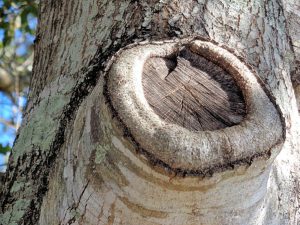
We have an abundance of wounded trees after the hurricane, and they need some time to heal. But trees never heal their wounds – they seal them up! A wound causes the tree to react by putting down layers of wood to shut out the outside world, full of its fungal, bacterial, and insect invaders. However, we can help trees along by making proper pruning cuts and managing the wounds in way that lets the tree do what comes naturally. Some understanding of the tree wound sealing process will bring success to all of your pruning efforts.
In the “olden days”, the standard pruning practice was to make a “flush cut” where you would remove a branch flush with the trunk. The wound left never really was able to seal up well and as a result there was often exposed inner tissue that was open to decay. Years later, and with a great deal of research, experts found that simply adjusting the pruning cut to just outside what is called the branch collar region did the trick. The branch collar is a slightly swollen area where the branch connects to the trunk. Many tree species have prominent branch collars and even another visual cue called a branch bark ridge located just above the collar. The pruning cut should be made just outside the branch collar at a bit of an outward, downward slant. Your work is now over! The tree will take it from here. The tree, both physically and chemically, keeps organisms at bay when the branch collar is intake.

In reaction to the pruning cut, the tree begins to develop callus tissue. This tissue rolls out from the edge of the wound and eventually covers it. About a year after the cut, the callus tissue looks like a donut of sorts – round with an opening in the middle. Another season or so and the callus tissue has enclosed the wound. Eventually the formerly cut area slowly “grows away” and fades into a smooth shadow of its former self. The tree has responded with what is called “compartmentalization” which simply means that it has isolated the old tissue with new tissue – a protective barrier.
In addition to proper pruning, another tip is not to use any pruning seal. If a proper pruning cut is made, the tree will take care of the rest of the process. Commercial pruning seal may actually lock in organisms that promote decay thus defeating the purpose of the seal in the first place. The pruning seal material can inhibit callus tissue production and compartmentalization.
Proper pruning goes a long way towards the future health and stability of your tree. Make the proper pruning cut and the tree is pre-programmed to take care of itself! For more information on all types of tree and shrub pruning information, please contact Ralph E. Mitchell, Director/Horticulture Agent for UF/IFAS Extension – Charlotte County. He can be reached at 941-764-4344 or ralph.mitchell@charlottecountyfl.gov. Connect with us on social media. Like us on Facebook @CharlotteCountyExtension and follow us on Instagram @ifascharco
Resources:
Gilman E. F. and Bisson, A. (2017) Chapter 12—Developing a Preventative Pruning Program: Young Trees. The University of Florida Extension Service, IFAS.
Clatterbuck, W. K. (2006) Tree Wounds: Response of Trees and What You Can Do. The University of Tennessee.
Thompson, M. Y. (2001) Why not use pruning sealers? New Mexico State University.
Schalau, J. (2010) Pruning Sealants Can Inhibit Healing. University of Arizona Cooperative Extension – Yavapai County.
Chalker-Scott, L. (2022) The Myth of Wound Dressings: “Apply wound dressing after pruning to insure against insect or fungal invasion”. Washington State University, Puyallup Research and Education Center.
Source: UF/IFAS Pest Alert



